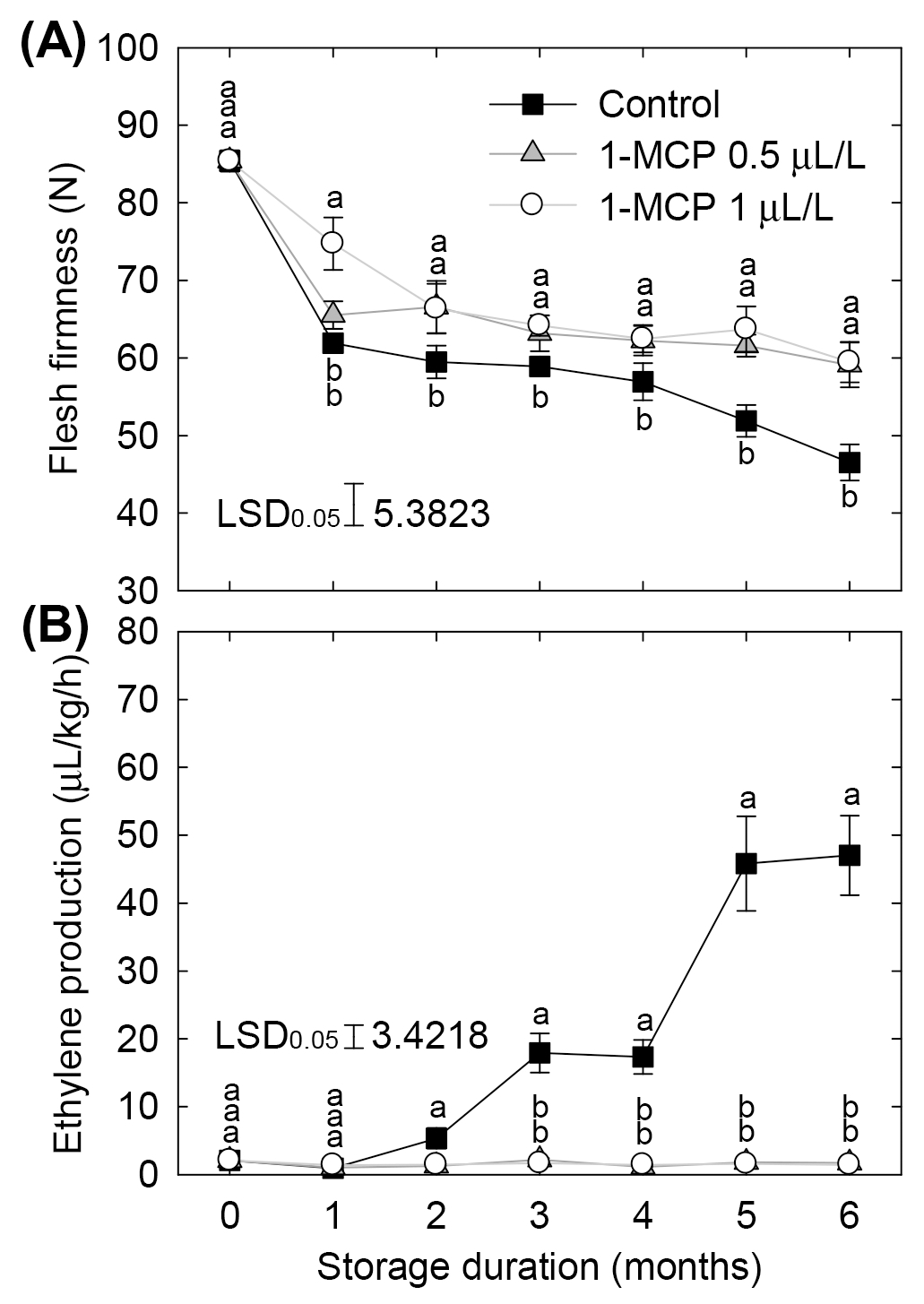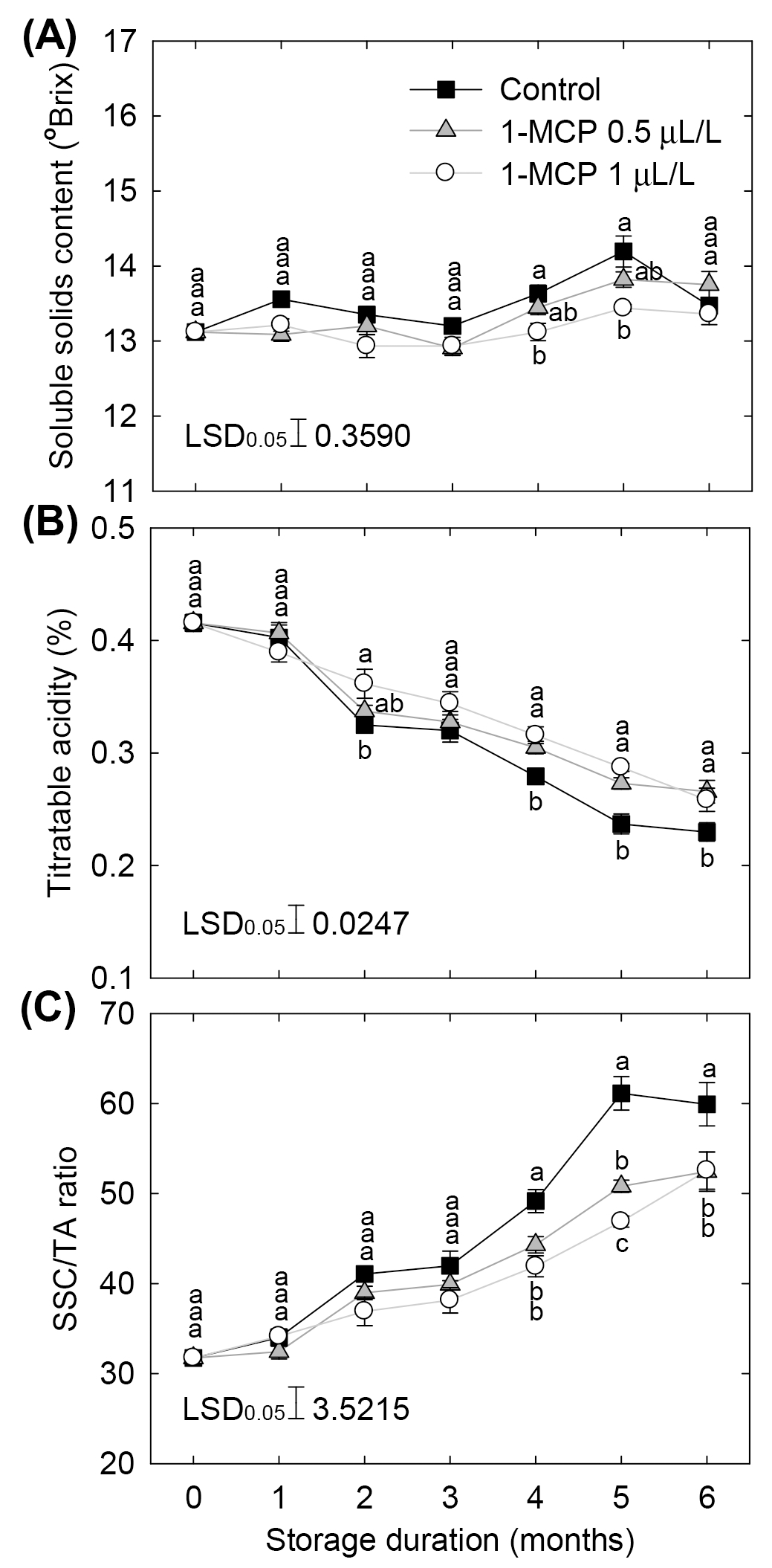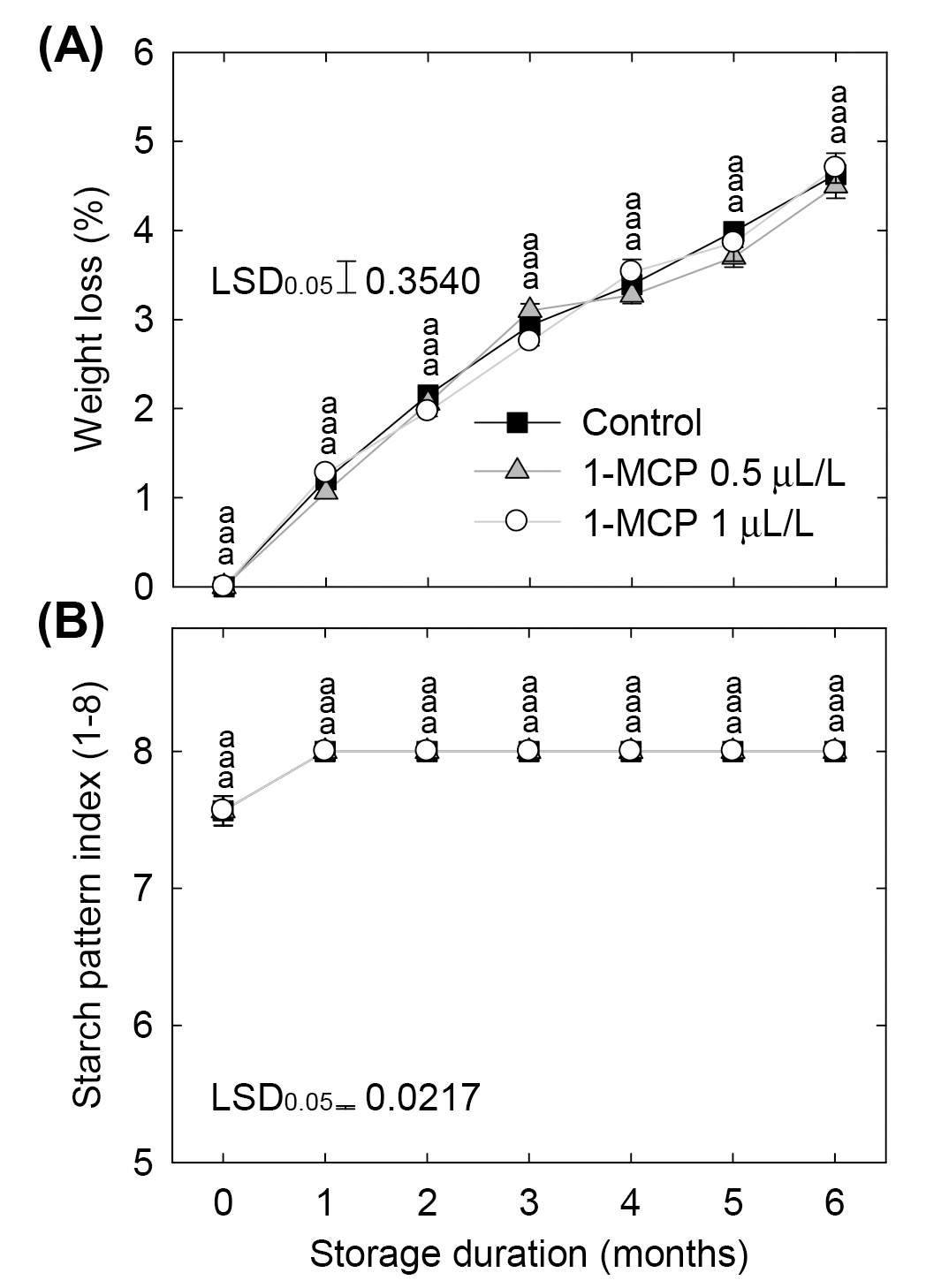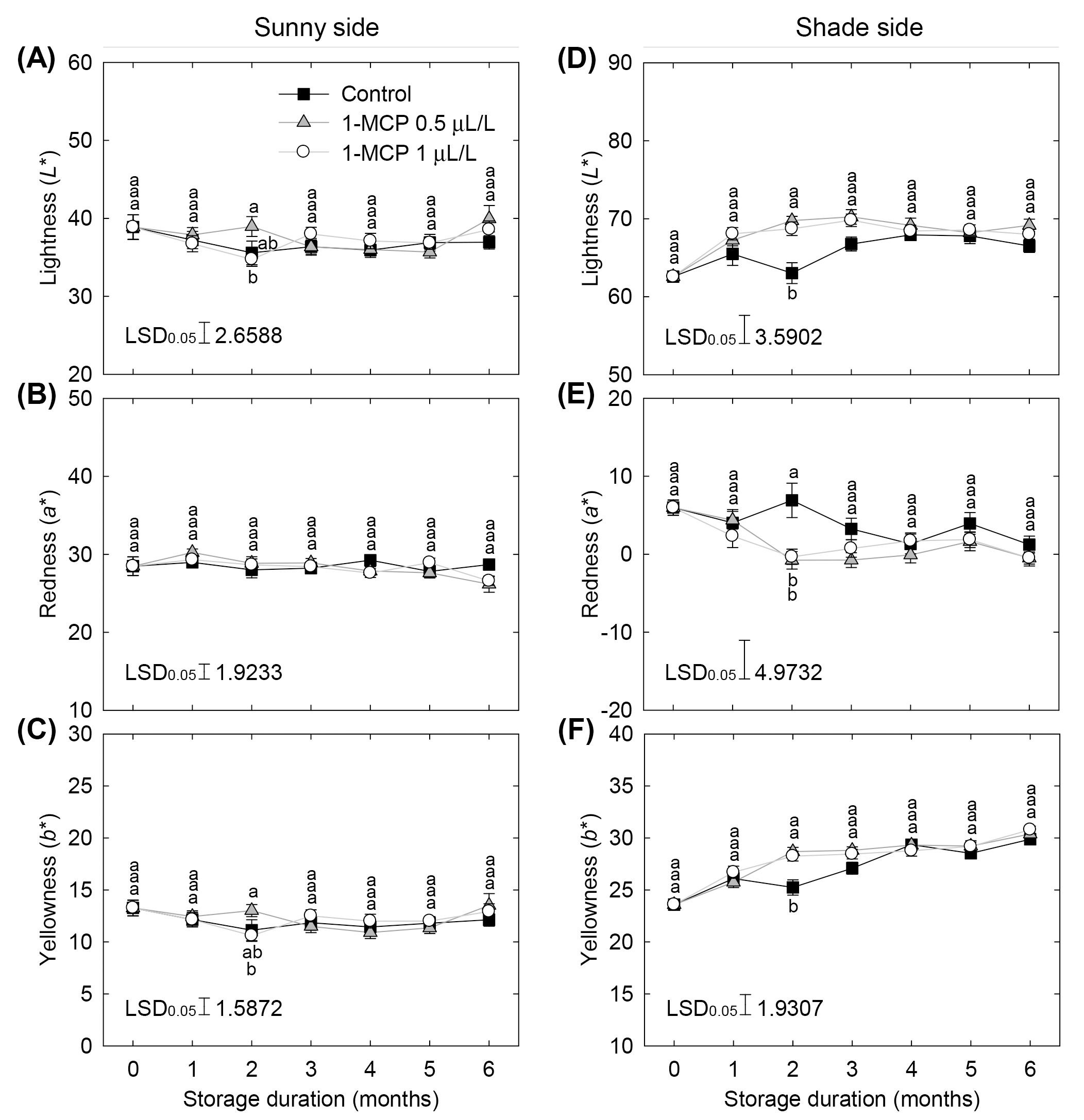1. 서론
국내 사과 산업은 최근 약 33,000 ha의 면적에서 약 500,000톤의 사과를 생산하고 있으며 ‘후지’, ‘홍로’ 등과 같은 대과종의 적색 사과가 대부분을 구성하고 있다(Statistics Korea, 2019). 그러나 국내에서는 최근 2인 가구 또는 단일가구로 가족 구성형태가 변해감에 따라 소비자의 과실 구매형태 또한 휴대가 편의하고 과실품질이 우수한 중소과를 선호하는 형태로 변화하고 있다(Yoo 등, 2020a; Yoo 등, 2020b). 특히, 소과종 사과품종의 경우 어린이들도 부담 없이 한 번에 섭취할 수 있어 학교, 유치원, 어린이집 등 급식용으로 보급이 가능하며, 그 외에 제빵용 및 간편식 등으로 이용할 수 있는 ‘snack-size’라고 불리는 미니형 소과종 사과의 시장성이 점차 증가하고 있다(Kwon 등, 2019). 이에 적합한 RubyS(루비에스) 사과는 농촌진흥청 국립원예특작과학원 사과연구소에서 ‘알프스오또메’ב산사’를 교배하여 2014년 육성된 소과종 품종이다(Kwon 등, 2019). 과실특성을 보면, 성숙기는 8월 중순이고 과피색은 홍색으로 밝은 광택을 나타내며, 과중은 약 70.0 g 정도, 당도는 13.0 °Brix, 산도는 0.42%로 감미가 우수한 것으로 평가를 받고 있다. 그럼에도 불구하고 ‘루비에스’ 사과는 국내의 사과품종 시장을 다양화하면서도 장기간 공급할 수 있는 수확 후 장기저장에 대한 연구가 부족하여 단기저장을 통해 유통 · 판매시키고 있는 실정이다.
사과에서 에틸렌 발생량은 수확 후 과실의 성숙과 노화에 관여하여 품질변화에 영향을 미치는 것으로 알려져 있어 에틸렌을 효율적으로 조절하는 것이 중요하다(Abeles 등, 1992; Saltveit, 1999; Yoo 등, 2020b). 이러한 에틸렌의 발생 및 작용을 효율적으로 억제하기 위하여 에틸렌 작용억제제인 1-methylcyclopropene(1-MCP)이 적용되고 있다(Watkins, 2006). 그동안 연구결과에서는 1-MCP는 에틸렌 작용과 발생을 억제하지만, 과실품종과 저장 형태 및 저장기간에 따라 그 효과는 차이를 보인다고 하였다(Fan과 Mattheis, 1999; Mattheis 등, 2005; Saftner 등, 2003; Watkins 등, 2000; Watkins와 Nock, 2005). 특히, 1-MCP의 처리농도는 과실 종류 및 품종, 그리고 약제처리시 과실의 성숙 단계에 따라 효과에 차이가 있으며, 농도에 따라 약해가 유발될 수도 있어 적합한 농도로 처리하는 것이 매우 중요하다고 하였다(Pre-Aymard 등, 2003; Rupasinghe 등, 2000; Watkins 등, 2000). 그러나 변화하고 있는 국내 사과 재배품종들에 대한 1-MCP 적정 처리농도 연구는 최근 일부 품종을 대상으로 시작되었을 뿐(Kwon 등, 2021; Kwon 등, 2022; Yoo 등, 2020a; Yoo 등, 2020b), 여전히 대부분의 사과에 적용되고 있는 1-MCP는 1 μL/L의 농도로 일관되게 적용하고 있어 처리농도에 관한 연구는 미미한 실정이다.
따라서 소과종 ‘루비에스’ 사과에 대하여 수확 후 1-MCP 처리농도에 따른 저장동안 과실품질에 미치는 영향을 분석함으로써, 효율적인 1-MCP 처리농도와 저장한계기를 구명하고자 본 연구를 수행하였다.
2. 재료 및 방법
본 실험은 경상북도 영천시 임고면 농가에서 재배되고 있는 수세가 안정된 ‘루비에스/M.9’ 6년생 나무를 대상으로, 2020년 8월 27일에 수확하여 경북대학교 원예생산물품질관리학 실험실로 이동한 후, 감염 및 손상된 상처과들을 제외하고 균일한 과실을 선별하여 실험재료로 사용하였다.
과실을 수확 후 1-MCP(상품명: SmartFresh™, Agro Fresh, Yakima, WA, USA) 처리는 무처리, 0.5 및 1 μL/L의 농도로 7.8 m3의 밀폐된 공간에 과실을 적재한 후 18시간 동안 실온에서 각각 훈증 처리하였다. 저장조건은 온도 0±0.5°C, 상대습도 90%로 설정하여 6개월간 저장하였고, 과실의 특성조사는 수확 당일 및 저장 1개월 간격으로 총 7회 실시하였다.
모든 과실은 조사 1일 전 과실을 저장고에서 꺼내어 실온(20°C)에서 품온을 평형시킨 후, 처리당 5개의 과실을 1반복으로 하여 3반복 총 15개의 과실을 대상으로 측정하였다. 과실 경도는 직경 11 mm plunger를 장착한 과실경도계(Compac-100II, Sun Scientific Co., Tokyo, Japan)를 사용하여 과실 적도부의 과피를 제거한 뒤 과실당 3회 측정한 값을 평균하여 Newton(N)으로 나타내었다. 에틸렌 발생량은 저장 과실을 실온(20±1°C)에서 품온을 평형시킨 후 측정하였다. 과실을 1.6 L 용기에 3개 넣고 밀폐 후 1시간 후에 용기 내의 공기를 1 mL gas 상태로 채취하여 FID(flame ionization detector)를 장착한 gas chromatography(GC 7820A, Agilent Technologies Inc., Santa Clara, CA, USA)를 이용하여 측정하였다. FID 분석조건은 porapak Q column(80/100 1 m, RASTEK, Bellefonte, PA, USA)을 사용하였고, injector, oven, detector 온도는 각각 100, 90, 250°C로 설정하였으며, carrier gas는 He를 사용하였고 flow rate는 25 mL/min으로 하였다.
가용성 고형물 함량(soluble solids content, SSC)은 착즙한 과즙을 디지털당도계(PR-201α, Atago Co., Ltd., Tokyo, Japan)를 이용하여 측정하였고, 산 함량(titratable acidity, TA)은 전위차 적정기(DL-15, Mettler Toledo Co., Greifensee, Switzerland)를 사용하여 과즙 5 mL를 0.1 N NaOH로 pH 8.1까지 적정한 뒤 투입량을 malic acid로 환산하였다. 당산비는 가용성 고형물과 산 함량의 비율로 나타내었다.
과실의 중량감소율은 수확 시 처리별 50개 과실의 과중을 측정한 후 저장기간 동안 과중의 변화를 측정하여 백분율로 나타냈다. 전분지수는 Cornell Starch Index를 참고하여 관능적으로 평가하였다(Blanpied and Silsby, 1992). 과피의 색도는 색차계(CR-400, Konica Minolta Inc., Tokyo, Japan)를 이용하여 과실의 양광면(sunny-side)과 바탕면(shade-side)을 각각 3곳을 측정하여 평균값으로 나타내었다.
3. 결과 및 고찰
‘루비에스’ 사과의 수확 시 과실 특성은 Table 1과 같다. 과중은 75.0 g, 경도는 85.4 N, 가용성 고형물과 산 함량은 13.1 °Brix, 0.42%로 그 특성이 발현되었다. 그리고 과피 양광면의 적색도(a*) 역시 28.5로 착색이 우수하였고, 수확 시 에틸렌 발생량은 2.63 μL/kg/h이었으며 전분지수(starch pattern index, SPI)는 성숙기에 근접한 7.56을 보였다.
‘루비에스’ 사과의 경도 변화는 다음과 같다(Fig. 1(A)). 무처리 과실은 수확 시 85.4 N에서 저장 1개월 후 61.9 N 정도로 급격히 감소하였고, 저장 2개월 후에는 59.5 N의 경도를 나타내었으나 이후 서서히 감소하여 저장 6개월 후에는 46.5 N의 과실 경도를 나타내었다. 그러나 1-MCP 처리구의 경우 0.5 μL/L의 농도에서는 저장 1개월 후 무처리구와 동일한 수준의 경도 감소를 나타내었으나, 저장 2개월 이후 경도 감소가 지연되면서 1 μL/L의 처리구와 차이가 없이 낮은 경도 감소율을 보였으며 저장 6개월 후에는 1-MCP 처리 과실들은 59.1-59.5 N으로 높은 과실 경도를 보였다. 그리고 1-MCP 처리 후 저장기간에 따른 에틸렌 발생량을 보면(Fig. 1(B)), 무처리 과실은 수확 시 2.1 μL/kg/h이었고, 저장 2개월 후부터 증가하기 시작하여 저장 6개월 후에는 47.0 μL/kg/h까지 급격히 증가하였다. 그러나 1-MCP 처리구들은 처리농도에 따른 차이 없이 1.4-1.7 μL/kg/h로 매우 낮은 에틸렌 발생량을 보였다. Watkins(2006)는 과실의 연화가 1-MCP에 의해 억제될 수 있다고 하였으며, 1-MCP에 의해 영향을 받는 식감과 관련된 구성 요소는 충분히 조사되지 않았지만, 과실 조직의 인장력은 1-MCP 처리된 과일에서 더 크다고 보고하였다(Baritelle 등, 2001). 그리고 국내 육성 사과품종인 Summer King과 Green Ball 사과에서도 1-MCP 처리 효과를 보여 에틸렌 발생량 억제와 함께 과실의 높은 경도를 유지하였다(Win 등, 2019). 1-MCP는 과실에 적용 시 에틸렌 작용 억제와 추가로 발생하는 에틸렌 발생량을 감소시키고(Kwon 등, 2021; Mattheis 등, 2005; Watkins, 2007; Watkins 등, 2000), 이는 에틸렌 생합성 과정에 Md-ACS1과 Md-ACO1 유전자의 발현에 관여함으로써(Kwon 등, 2017) 과실의 경도 감소를 억제하는 데 효과적이라 하였다. 그러나, Pre-Aymard 등(2003)은 Anna 사과에 1-MCP를 0.01, 0.1, 그리고 1 μL/L 농도로 처리하였을 때 0.1 μL/L 이하의 농도에서는 효과를 나타내지 않는다고 하였고, Watkins 등(2000)은 1-MCP를 0.5, 1, 그리고 2 μL/L 농도로 처리하였을 때, Mcintosh와 Law Rome 사과는 0.5 μL/L 처리구가 과실품질 유지에 부분적인 효과를 나타내었지만, Empire, Delicious 사과의 경우 0.5 μL/L 처리구 역시 1 μL/L과 2 μL/L 처리구와 같이 과실품질 유지에 효과적이라고 보고하였다. 따라서 ‘루비에스’ 사과에도 1-MCP 처리가 과실의 경도 감소와 에틸렌 발생 억제에 동일한 효과를 보여 소과종 사과의 과실품질 유지에 효과적이며, 특히 1-MCP 0.5 μL/L 농도 처리는 1 μL/L 처리와 동일한 효과를 보여 ‘루비에스’ 사과에 적용이 가능한 농도라고 판단되었다. 따라서 ‘루비에스’ 사과는 무처리구의 경우 저온저장에서 경도가 60.0 N 수준을 유지하며 에틸렌의 발생량이 급격히 증가되기 직전인 수확 후 2개월이 저장한계기로, 1-MCP 처리의 경우 농도에 차이가 없이 6개월까지도 저장이 가능할 것으로 판단되었다(Yoo와 Kang, 2021).

‘루비에스’ 사과의 가용성 고형물 함량(Fig. 2(A)) 변화는, 무처리구의 경우 수확 시 13.1 °Brix이었고 저장 6개월 후에도 13.5 °Brix로 유지되었다. 1-MCP 처리구들 역시 처리농도와 관계없이 저장기간 동안 비슷한 가용성 고형물 함량을 나타내었으며, 무처리구와 차이를 보이지 않았다. 반면, 과실의 산 함량은(Fig. 2(B)) 수확 시 0.42%이었고, 무처리구의 경우 저장기간이 길어질수록 지속적으로 감소하여 저장 4개월 후 0.28%, 5개월 후 0.24%, 그리고 6개월 후 0.23%의 산 함량을 보였지만, 1-MCP 처리 과실들은 저장 4개월 후 0.31-0.32%, 5개월 후 0.27-0.29%, 그리고 6개월 후 0.26-0.27%의 산 함량을 보여, 무처리 과실과 비교하여 산 함량이 높게 유지되었다. 그동안의 연구결과를 보면 사과 과실에 1-MCP 처리 시 저장기간 동안 산 함량의 감소를 지연시킨다고 하였다(Defilippi 등, 2004; Fan과 Mattheis, 2001; Pre-Aymard 등, 2003; Pre-Aymard 등, 2005; Saftner 등, 2003; Toivonen과 Lu, 2005; Watkins 등, 2000). 이는 국내에서 재배된 ‘홍옥’, ‘후지’, ‘홍로’, ‘감홍’ 사과에서 역시 1-MCP를 처리하였을 때 에틸렌 발생량이 현저히 억제되고 경도와 산 함량은 높게 유지되었다(Lim 등, 2007; Lim 등, 2009; Park 등, 2016; Yoo 등, 2013; Yoo 등, 2015). 그러나, 가용성 고형물 함량의 경우 1-MCP를 처리하였을 때 무처리 과실과 비교하여 품종과 재배 및 저장 환경에 따라 높거나 낮을 수 있으며, 그리고 그 차이는 미미하다고 하였다(Moran과 McManus, 2005; Pre-Aymard 등, 2005; Watkins 등, 2000; Zanella, 2003). 이는 외국 사과품종인 Mcintosh와 Empire 사과에서(DeEll 등, 2016), 그리고 국내 사과품종인 ‘썸머프린스’와 ‘썸머킹’ (Yoo 등, 2020a), ‘홍금’(Yoo 등, 2020b) 사과에서도 1-MCP 처리가 가용성 고형물의 함량 변화에 미치는 영향이 없었다고 하여 ‘루비에스’ 사과에서도 동일한 경향을 보였다. 그리고 가용성 고형물과 산 함량의 비율을 나타내는 당산비를 보면(Fig. 2(C)), 무처리 과실에서 산 함량이 감소하면서 당산비가 급격히 증가하였지만 1-MCP 처리과실들은 상대적으로 낮은 결과를 보여 산 함량이 유지되는 효과를 보여 과실의 품질이 유지되는 결과를 보였다. ‘썸머프린스’와 ‘썸머킹’ 사과 역시 무처리 과실은 저장기간 동안 당산비가 증가하였으나, 1-MCP 처리 과실들은 산 함량의 변화를 억제하여 당산비의 변화가 낮아 과실의 신선도가 유지되었다고(Yoo 등, 2020a) 한 결과와 동일하였다. 따라서 ‘루비에스’ 사과에도 1-MCP 처리가 과실의 산 함량 감소와 당산비의 변화 억제에 효과를 보여 소과종 사과의 식미 유지에 효과적이며, 1-MCP 처리 농도에 따른 차이가 없었다.

‘루비에스’ 사과의 중량감소율은(Fig. 3(A)), 무처리구와 1-MCP 처리구들 간에 차이가 없이 저장기간이 길어질수록 증가하는 경향으로, 저장 3개월 후에는 2.75-3.10%로 품질이 유지되었으나 저장 6개월 후에는 4.50-4.70%로 중량감소율이 증가하여 외관상 품질이 하락하는 현상을 보였다. Jackson 등(1971)은 무게가 적게 나가는 소과종 사과에서 무게가 상대적으로 무거운 대과종 사과와 비교하여 높은 중량감소율을 보이며, 이는 과중 대비 소과종 과실의 표면적 비율이 대과종 비교하여 크기 때문이라고 하였다. Yoo 등(2021) 역시 국내 사과 재배품종 중 가장 높은 재배면적과 생산량을 나타내는 ‘후지’ 사과의 경우 저온 저장 6개월 후 약 1.50%의 중량감소율을 보였으며, 그 외 대과종인 ‘감홍’ 사과 및 중소과 사과 품종인 ‘황옥’과 ‘피크닉’ 사과의 경우 저장 6개월 후 각각 1.70, 1.60, 2.60%의 중량감소율을 보인다고 하였다. 따라서 ‘루비에스’ 사과는 기존에 널리 재배되고 있는 사과품종과 비교하여 높은 중량감소율을 보여 장기저장을 위하여 개선이 필요한 부분이라고 판단된다. 또한, 1-MCP 처리하였을 때 ‘감홍’과 ‘썸머프린스’ 사과는 저온저장 후 낮은 중량감소율을 보였으나, ‘후지’, ‘황옥’, ‘피크닉’, 그리고 ‘썸머킹’ 사과는 중량감소율의 차이가 없다고 하였다(Win 등, 2019; Yoo 등, 2020a; Yoo 등, 2021). 따라서 저장기간 동안 1-MCP 처리 시 중량감소율에 미치는 영향은 사과품종에 따라 다소 차이가 있는 것으로 판단되었다. 그리고 수확 시와 저장기간에 따른 전분지수(SPI)의 변화를 보면(Fig. 3(B)), 수확 시에는 거의 성숙에 해당되는 SPI 7.56을 보였고, 저장 1개월 후에는 처리구 간 차이가 없이 완전 성숙인 SPI 8.00을 보여 전분이 포도당으로 완전히 분해됨을 확인하였다. 사과 과실의 경우 과실의 전분함량은 과실의 성숙 정도를 판단하는 데 이용되며 본 연구에 사용된 과실은 수확 시 거의 성숙이 완료된 것으로 확인되었다(Brookfield 등, 1997; Magein과 Leurguin, 2000). 그리고 Watkins 등(2000) 1-MCP의 처리 효과는 처리 농도 및 시간, 그리고 과실의 성숙단계에 따라 차이를 보인다고 하였으며, 특히 과성숙한 과실에 1-MCP를 처리하였을 때 그 효과가 감소된다고 하여 본 연구의 전분지수 변화에 미치는 영향은 미미한 것으로 판단되었다.

‘루비에스’ 사과의 수확 시 양광면(sunny-side, Fig. 4(A)-(C))과 바탕색(shade-side, Fig. 4(D)-(F))의 과피 착색을 조사하였다. 수확 시 양광면의 과피 명도(L*)는 38.9, 적색도(a*)는 28.5, 등황색(b*)은 13.3을 보였고, 저장기간 및 1-MCP 처리에 따른 차이는 보이지 않았다. 그리고 모든 처리구들에서 과피의 바탕색을 측정한 L*값과 b*값은 저장기간이 길어질수록 점점 증가하는 경향을 보였으나, a*값은 저장기간 동안 변화를 보이지 않았다. Dauny와 Joyce (2002)는 일반적으로 상업적 측면에서 부정적인 요소로 간주되는 녹색을 띠는 과피 바탕색의 감소는 1-MCP 처리 유무에 따라 차이를 보이지 않는다고 하였다. 국내 육성품종인 ‘썸머킹’, ‘감홍’ 사과에 1-MCP 처리 시 과피색의 변화에는 영향이 없었고(Kim 등, 2018; Yoo 등, 2020a), Honeycrisp 사과도 1-MCP 처리에 따른 착색변화에 미치는 영향은 없었다고 하였다(Mattheis 등, 2017). 그러나 1-MCP를 처리 시 때에 따라 과피색의 변화를 지연시키는 경향을 보이기도 하여 재배 및 저장 환경, 또는 과실품종에 따라 1-MCP 효과에 차이가 있는 것으로 보고되고 있다(Blankenship과 Dole, 2003).

이상의 결과를 종합해 보면, 소과종 ‘루비에스’ 사과에 1-MCP 처리는 0.5와 1 μL/L의 농도와 관계없이 저장 6개월까지도 60 N 수준의 경도를 유지하였고, 에틸렌 발생량은 매우 낮게 유지하였다. 또한, 산 함량도 무처리 과실에 비하여 높게 유지하였다. 그러나 중량감소율은 저장 3개월 이후부터는 현저히 증가되어 과실품질 유지에 한계가 있었다. 따라서 ‘루비에스’ 사과는 무처리 과실은 저장 2개월이 한계기로, 그리고 1-MCP 처리 시 0.5 μL/L의 농도도 1 μL/L 농도와 차이가 없었고, 중량감소율을 제외하면 6개월까지도 저장이 가능할 것으로 판단되었다.
